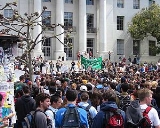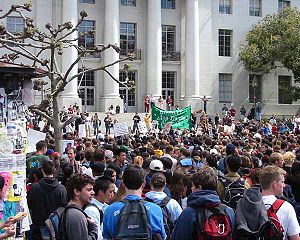
Sproul Plaza
Encyclopedia


University of California, Berkeley
The University of California, Berkeley , is a teaching and research university established in 1868 and located in Berkeley, California, USA...
. It is divided into two sections: Upper Sproul and Lower Sproul. They are separated by 12 vertical feet and a set of stairs.
History
Sproul Plaza as well as Sproul Hall are named for former University of California president Robert Gordon SproulRobert Gordon Sproul
Robert Gordon Sproul was eleventh President of the University of California serving from 1930 to 1958....
. The Plaza was designed by landscape architect Lawrence Halprin
Lawrence Halprin
Lawrence Halprin was an influential American landscape architect, designer and teacher.Beginning his career in the San Francisco Bay Area, California, in 1949, Halprin often collaborated with a local circle of modernist architects on relatively modest projects. These figures included William...
in 1962. At the time, the University was expanding its core campus southward from its prior border at Strawberry Creek to Bancroft Avenue, and acquired acres of commercial and residential properties in the south campus Telegraph Avenue area.
Upper Sproul Plaza is bordered to the east by Sproul Hall, which was formerly the location of the campus administration, and is today the location of student and admission services. To the north is Sather Gate
Sather Gate
Sather Gate is a prominent landmark separating Sproul Plaza from the bridge over Strawberry Creek, leading to the center of the University of California, Berkeley campus. The gate was donated by Jane K. Sather, a benefactor of the university, in memory of her late husband Peder Sather, a trustee of...
, which leads into the central campus, and to the south are Telegraph Avenue
Telegraph Avenue
Telegraph Avenue is a street that begins, at its southernmost point, in the midst of the historic downtown district of Oakland, California, USA, and ends, at its northernmost point, at the southern edge of the University of California campus in Berkeley, California...
and the South Campus
Southside, Berkeley, California
Southside, also known by the older names South of Campus or South Campus, is a neighborhood in Berkeley, California. Southside is located directly south of and adjacent to the University of California, Berkeley campus...
area of Berkeley
Berkeley, California
Berkeley is a city on the east shore of the San Francisco Bay in Northern California, United States. Its neighbors to the south are the cities of Oakland and Emeryville. To the north is the city of Albany and the unincorporated community of Kensington...
. Sproul Hall is situated on a rise above Upper Sproul Plaza and features a broad, terraced stairway leading to the entrance. Large numbers of students walk past Sproul Hall on the way to class or on the way to Telegraph Avenue.
The combination of a stairway that can be used as a large raised platform and a ready audience makes Upper Sproul Plaza a popular location for student protests, the first of which occurred in 1964 during the Free Speech Movement
Free Speech Movement
The Free Speech Movement was a student protest which took place during the 1964–1965 academic year on the campus of the University of California, Berkeley under the informal leadership of students Mario Savio, Brian Turner, Bettina Aptheker, Steve Weissman, Art Goldberg, Jackie Goldberg, and...
, when Mario Savio
Mario Savio
""...But we're a bunch of raw materials that don't mean to be - have any process upon us. Don't mean to be made into any product! Don't mean - Don't mean to end up being bought by some clients of the University, be they the government, be they industry, be they organized labor, be they anyone!...
spoke from the Sproul Hall steps, and folk singer Joan Baez
Joan Baez
Joan Chandos Baez is an American folk singer, songwriter, musician and a prominent activist in the fields of human rights, peace and environmental justice....
gave an early performance. A small round brass marker, embedded in the concrete, declares them as the "Mario Savio Steps." Upper Sproul Plaza was also the site of early teach-ins and protests against the Vietnam War
Vietnam War
The Vietnam War was a Cold War-era military conflict that occurred in Vietnam, Laos, and Cambodia from 1 November 1955 to the fall of Saigon on 30 April 1975. This war followed the First Indochina War and was fought between North Vietnam, supported by its communist allies, and the government of...
, the 1969 tear gassing of People's Park
People's Park (Berkeley)
People's Park in Berkeley, California, USA, is a park off Telegraph Avenue, bounded by Haste and Bowditch streets and Dwight Way, near the University of California, Berkeley. The park was created during the radical political activism of the late 1960s....
protesters by the National Guard, 1985 protests against University investment in apartheid-era South Africa, and many other political events.
During calmer times, numerous student groups set up tables to recruit and inform other students (a practice known as "tabling," as occurs at many universities throughout the United States). Upper Sproul Plaza also features a double row of the pollarded
Pollarding
Pollarding is a pruning system in which the upper branches of a tree are removed, promoting a dense head of foliage and branches. It has been common in Great Britain and Europe since medieval times and is practiced today in urban areas worldwide, primarily to maintain trees at a predetermined...
London Plane
London Plane
Platanus × acerifolia, the London plane, London planetree, or hybrid plane, is a tree in the genus Platanus. It is usually thought to be a hybrid of Platanus orientalis and the Platanus occidentalis . Some authorities think that it may be a cultivar of P...
trees characteristic of the Berkeley campus.
Lower Sproul Plaza, directly west of Upper Sproul Plaza, is the location of numerous small musical and cultural performances and is surrounded by numerous brutalist-style 1960s-era buildings owned by the ASUC, including Eshleman Hall to the south and the Martin Luther King, Jr.
Martin Luther King, Jr.
Martin Luther King, Jr. was an American clergyman, activist, and prominent leader in the African-American Civil Rights Movement. He is best known for being an iconic figure in the advancement of civil rights in the United States and around the world, using nonviolent methods following the...
Student Union to the east, as well as the César E. Chávez
César Chávez
César Estrada Chávez was an American farm worker, labor leader, and civil rights activist who, with Dolores Huerta, co-founded the National Farm Workers Association, which later became the United Farm Workers ....
Student Center to the north and Zellerbach Hall
Zellerbach Hall
Zellerbach Hall is a multi venue performance facility on the campus of the University of California, Berkeley. It was designed by architect and professor Vernon DeMars and completed in 1968...
to the west. Eshleman Hall houses the ASUC Senate as well as the offices of various student groups. (Although it was rated "seismically very poor" in the last campus earthquake readiness evaluation, the ASUC lacks the funds to retrofit the building.) The Martin Luther King, Jr. Student Union is home to the Pauley Ballroom, the student store, and the "Bear's Lair" food court. The César E. Chávez Student Center houses the Student Learning Center, the ASUC Mall (including the BEARcade), and the "Golden Bear Café" campus restaurant. Zellerbach Hall is the largest indoor performance auditorium on campus, and frequently hosts guest speakers as well as Cal Performances
Cal Performances
Cal Performances is the performing arts presenting, commissioning and producing organization based at the University of California, Berkeley.-Founding and Early Expansion:...
engagements.
Recent geological soil testing (2011) on three Plaza locations are the start of planned renovations of the ASUC owned properties and the underground garage in Lower Sproul, part of the UC's master plan.
In 2011, Sproul Plaza is the site of Occupy Berkeley
Occupy Berkeley
Occupy Berkeley is an ongoing series of demonstrations in Berkeley, California based in front of a Bank of America. It is an offshoot of the Occupy Wall Street movement.-Events:...
protests.
Popular culture
Sproul Plaza is referenced in the song "Sad but true" by The Transplants. Vocalist Tim Armstrong is a Berkeley native.External links
- demonstrate.berkeley.edu: An inactive webcam of Sproul Plaza that brings up privacyPrivacyPrivacy is the ability of an individual or group to seclude themselves or information about themselves and thereby reveal themselves selectively...
issues. - live webcams

